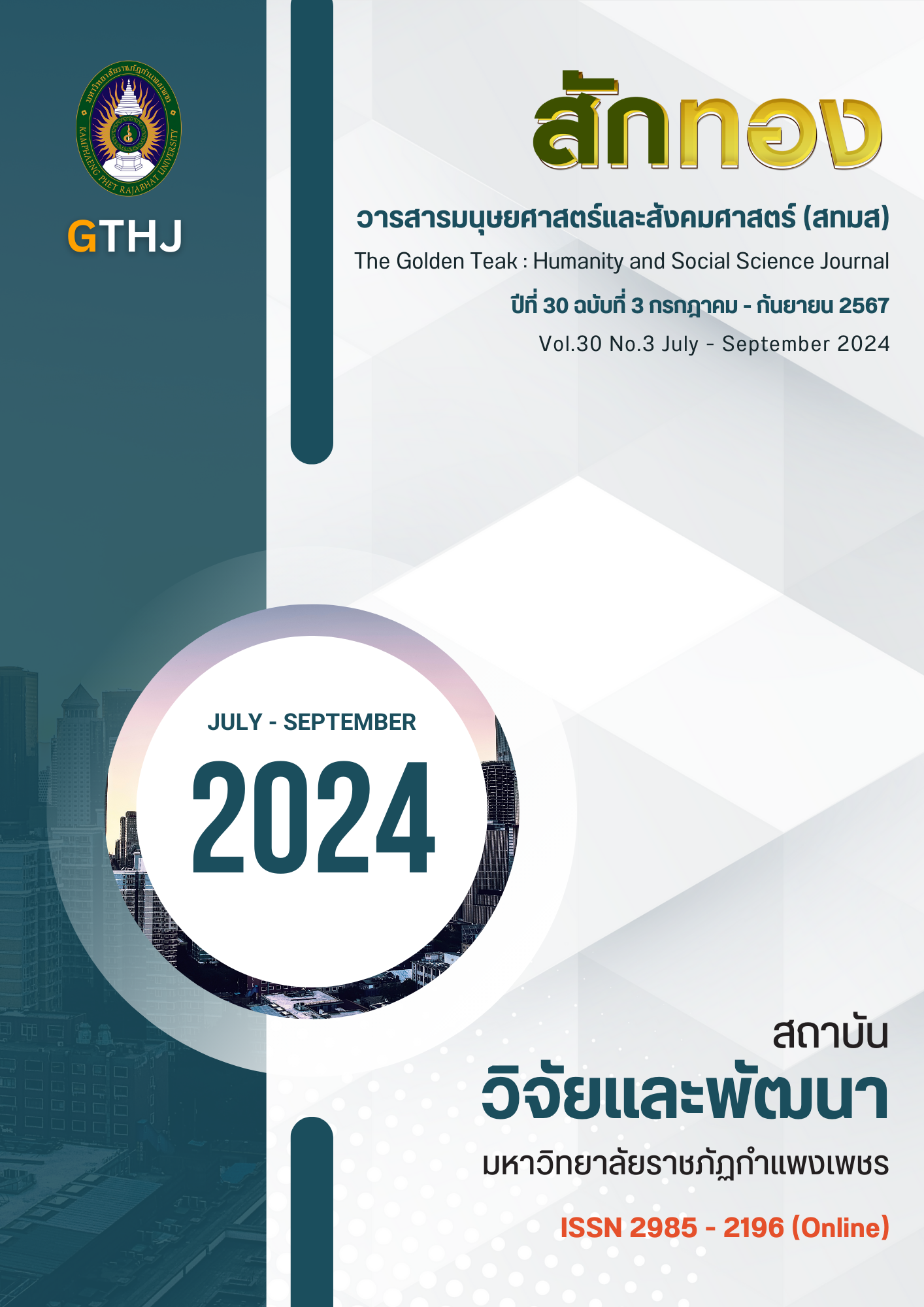ทุนทางสังคมกับการบริจาคในช่วงล็อกดาวน์โควิด-19
Main Article Content
บทคัดย่อ
การศึกษานี้มีวัตถุประสงค์เพื่ออธิบายระดับทุนทางสังคมกับการบริจาคและค้นหาปัจจัยที่มีอิทธิพลต่อการบริจาคในช่วงล็อกดาวน์โควิด-19 เก็บรวบรวมข้อมูลด้วยแบบสอบถามออนไลน์จากกลุ่มตัวอย่างที่มีอายุตั้งแต่ 20 ปี
ขึ้นไป ที่อาศัยอยู่ในกรุงเทพมหานคร จำนวน 1,200 คน สถิติในการวิเคราะห์ข้อมูล ได้แก่ สถิติเชิงพรรณนาและการวิเคราะห์การถดถอยพหุคูณแบบนำตัวแปรเข้าทั้งหมด ผลการวิจัยพบว่ากลุ่มตัวอย่างมีทุนทางสังคมระดับจุลภาค ทุนทางสังคมระดับมหภาค และพฤติกรรมการบริจาคอยู่ในระดับมาก โดยสถานที่ที่กลุ่มตัวอย่างให้การบริจาคมากที่สุด 3 อันดับแรก ได้แก่ ชุมชน โรงพยาบาล และบุคคลที่รู้จัก คิดเป็นมูลค่าเฉลี่ย 2,486.42 บาทต่อคน นอกจากนั้นยังพบว่าปัจจัยด้านประชากร ได้แก่ การนับถือศาสนาและระดับการศึกษาสูงสุด ปัจจัยภาวะกดดันของสถานการณ์ล็อกดาวน์โควิด-19 ปัจจัยทุนทางสังคมระดับจุลภาค ได้แก่ จิตสำนึกสาธารณะ ความไว้วางใจต่อกันในสังคม การมีส่วนร่วมในเครือข่ายสังคม และปัจจัยทุนทางสังคมระดับมหภาค ได้แก่ การอบรมสั่งสอนจากสถาบันทางสังคม และความศรัทธาหรือความเคร่งศาสนามีอิทธิพลต่อการบริจาคอย่างมีนัยสำคัญทางสถิติที่ระดับ .05 ดังนั้นภาคส่วนที่เกี่ยวข้องควรส่งเสริมบทบาทของทุนทางสังคมที่เข้มแข็งเพื่อสร้างภูมิคุ้มกันให้แก่สังคมในยามที่ต้องเผชิญกับภาวะวิกฤต
Article Details

This work is licensed under a Creative Commons Attribution-NonCommercial-NoDerivatives 4.0 International License.
บทความที่ได้รับการตีพิมพ์เป็นลิขสิทธิ์ของวารสาร สักทอง : วารสารมนุษยศาสตร์และสังคมศาสตร์ สถาบันวิจัยและพัฒนา มหาวิทยาลับราชภัฏกำแพงเพชร
ข้อคิดเห็นใดๆ ที่ปรากฎในวารสารเป็นวรรณกรรมของผู้เขียนโดยเฉพาะ ซึ่งมหาวิทยาลัยราชภัฏกำแพงเพชรและบรรณาธิการไม่จำเป็นต้องเห็นด้วย
References
Arpannudin, I., Suryadi, K., Malihah, E. & Anggraeni, L. (2021). Philanthropy : The citizens’ social
capital amidst the pandemic. Proceeding ICHELSS 2021. (pp. 201-212). Jakarta : FIS
UNJ.
Arsyianti, L.D. & Kassim, S. (2021). Charity behavior during COVID-19 pandemic. Turkish
Journal of Islamic Economic, 8, 321-338.
Best, J.W. (1981). Research in education. New Jersey : Prentice Hall.
Burns, N. & Grove, S.K. (1997). The practice of nursing research: Conduct critique and
utilization. (3 rd ed.). Chicago : Rand Mcnally.
Chotiwan, P. (2016). Reed mat weaving and “capitals” of Bang Sakao community in
Chanthaburi. The Golden Teak : Humanity and Social Science Journal, 22(4), 1-17.
[In Thai]
Coleman, J.S. (1994). Foundations of social theory. Cambridge : Harvard University Press.
Cronbach, L.J. (1970). Essential of psychological testing. New York : Harper Row.
Degasperi, N.C. & Mainardes, E.W. (2017). What motivates money donation? a study on
external motivators. Revista de Administração, 52, 363–373.
Dhammakaya Foundation. (2005). A manual of peace: 38 steps towards enlightened living.
Bangkok : Dhammakaya Foundation.
Dhammathai. (2017). Giving. [Online]. Available: https://www.dhammathai.org/treatment/poem
/poem15.php [2020, June 5]. [In Thai]
Glanville, J.L., Paxton, P. & Wang, Y. (2016). Social capital and generosity : A multilevel
analysis. Nonprofit and Voluntary Sector Quarterly, 45(3), 526-547.
Hair, J.F., Black, W.C., Babin, B.J. & Anderson, R.E. (2010). Multivariate data analysis.
London : Prentice Hall.
Hossain, B. & Lamb, L. (2017). Associational capital and adult charitable giving : A Canadian
examination. Nonprofit and Voluntary Sector Quarterly, 46(5), 963-983.
Intria, M. (2017). Social capital. Narkbhutparitat Journal, 9(2), 14-25. [In Thai]
Jonas, K. (2012). Restoring civil societies: the psychology of intervention and engagement
following crisis. In Jonas, K., J. & Morton, T., A. (Eds.), Prosocial behavior in the
context of crisis (pp. 57-77). NJ : Wiley-Blackwell.
Kammun, S. (2008). Social capital and human capital development. [Online].
Available: https://tdri.or.th/wp-content/uploads/2012/11/g3_6_suwanee_final.pdf
, May 30]. [In Thai]
Khazanie, R. (1996). Statistics in a world of applications. (4 th ed.). New York : HarperCollins
College Publishers.
Latané, B. & Darley, J.M. (1970). The unresponsive bystander : Why doesn’t he help?
New York : Appleton-Century-Croft.
National Statistical Office Thailand. (2018). Social, cultural, and mental health survey 2018.
[Online]. Available: www.nso.go.th/sites/2014/DocLib13/ด้านสังคม/สาขาศาสนา/
ภาวะทางสังคมและวัฒนธรรม/2561/Full_report61.pdf [2020, June 25]. [In Thai]
Noor, A.H.M., Isa, N.A.M., Irpan, H.M., Bahrom, H.B, Salleh, A.M. & Ridzuan, A.R.B. (2015).
Characteristic affecting charitable donations behavior: Empirical evidence from
Malaysia. Procedia Economics and Finance, 31, 563-527.
Othman, A. & Sharim, M. H. (2022). Factors influencing the practice of charitable giving
pandemic situations: a preliminary study on Islamic relief Malaysia (IR Malaysia)
donors. Journal of Islamic Philanthropy & Social Finance, 4(2), 1-12.
Phuangprayong, K. (2021). The situation of impact, support needs and adaptation of working
age population during the COVID-19 pandemic : empirical study in Bangkok.
Suthiparithat Journal, 35(1), 266-286. [In Thai]
Puey Ungphakorn Institute for Economic Research. (2020). COVID-19 lockdown: Impact on
Thai workers in supply-side [Online]. Available: https://www.pier.or.th/abridged/2020
/08/ [2020, May 30]. [In Thai]
Putnam, R.D. (2000). Bowling alone: the collapse and revival of American community.
New York : Simon and Schuster.
Putnam, R.D. (2002). Democracies in flux: The evolution of social capital in contemporary
society. Oxford : Oxford University Press.
Ryandono, M.N.H., Kusuma, A., Maryani, A. & Wijayanti, I. (2022). Factors influence online
donation during COVID-19 pandemic. Al-Uqud : Journal of Islamic Economics, 6(1),
-85.
Salleh, A.M., Noor, A.H.M., Bahrom, H., Ridzuan, A.R. & Irfan, H. (2020). Landscape of
individual Muslim giving in Malaysia: An Analysis. Media Syari'ah : Wahana Kajian
Hukum Islam dan Pranata Sosial, 17(1), 39-80.
Stiglitz, J.E. (2012). The price of inequality: How today's divided society endangers our
future. New York : W.W. Norton & Company.
Thai Post. (2020). Bangkok lockdown: Closing 26 types of places. [Online]. Available :
https://www.thaipost.net/main/detail/60470 [2020, May 30]. [In Thai]
Thitatejo, P.D. (2021). Importance and Elements of Sanghahawatthu 4. Journal of Dhamma
for Life, 27(1), 1-10. [In Thai]
Wang, L. & Graddy, E. (2008). Social Capital, Volunteering, and Charitable Giving. Voluntas :
International Journal of Voluntary and Nonprofit Organizations, 19(1), 23-42.

